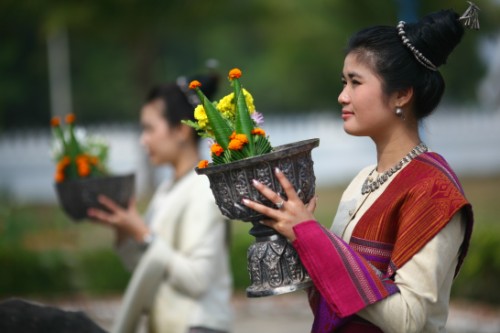Burmese primarily has a monosyllabic received Sino-Tibetan vocabulary. Nonetheless, many words, especially loanwords from Indo-European languages like English, are polysyllabic, and others, from Mon, an Austroasiatic language, are sesquisyllabic. Burmese loanwords are overwhelmingly in the form of nouns.
Historically, Pali, the liturgical language of Theravada Buddhism, had a profound influence on Burmese vocabulary. Burmese has readily adopted words of Pali origin because of phonotactic similarities between two languages alongside the fact that the script used for Burmese can reproduce Pali spellings with complete accuracy. Pali loanwords are often related to religion, government, arts, and science.
Burmese loanwords from Pali primarily take four forms:
Direct loan: direct import of Pali words with no alteration in orthography
"life": Pali ဇီဝ jiva → Burmese ဇီဝ jiva
Abbreviated loan: import of Pali words with accompanied syllable reduction and alteration in orthography (usually by means of a placing a diacritic, called athat အသတ် (lit. "nonexistence") atop the last letter in the syllable to suppress the consonant's inherent vowel[25]
"karma": Pali ကမ္မ kamma → Burmese ကံ kam
"dawn": Pali အရုဏ aruṇa → Burmese အရုဏ် arun
"merit": Pali ကုသလ kusala → Burmese ကုသိုလ် kusuil
Double loan: adoption of two different terms derived from the same Pali word[24]
Pali မာန māna → Burmese မာန [màna̰] "arrogance" and မာန် [màɴ] "pride"
Hybrid loan (e.g., neologisms or calques): construction of compounds combining native Burmese words with Pali or combine Pali words:[26]
"airplane": လေယာဉ်ပျံ [lè jɪ̀ɴ bjàɴ], lit. "air machine fly", ← လေ (native Burmese, "air") + ယာဉ် (from Pali yana, "vehicle") + ပျံ (native Burmese word, "fly")
Burmese has also adapted a great deal of words from Mon, traditionally spoken by the Mon people, who until recently formed the majority in Lower Burma. Most Mon loanwords are so well assimilated that they are not distinguished as loanwords as Burmese and Mon were used interchangeably for several centuries in pre-colonial Burma. Mon loans are often related to flora, fauna, administration, textiles, foods, boats, crafts, architecture and music.
As a natural consequence of British rule in Burma, English has been another major source of vocabulary, especially with regard to technology, measurements and modern institutions. English loanwords tend to take one of three forms:
Direct loan: adoption of an English word, adapted to the Burmese phonology
"democracy": English democracy → Burmese ဒီမိုကရေစီ
Neologism or calque: translation of an English word using native Burmese constituent words
"human rights": English "human rights" → Burmese လူ့အခွင့်အရေး (လူ့ "human" + အခွင့်အရေး "rights")
Hybrid loan: construction of compound words by native Burmese words to English words
"to sign": ဆိုင်းထိုး [sʰáɪɴ tʰó] ← ဆိုင်း (English, "sign") + ထိုး (native Burmese, "inscribe").
To a lesser extent, Burmese has also imported words from Sanskrit (religion), Hindi (food, administration, and shipping), and Chinese (games and food).[17] Burmese has also imported a handful of words from other European languages such as Portuguese.
Here is a sample of loan words found in Burmese:
suffering: ဒုက္ခ [doʊʔkʰa̰], from Pali dukkha
radio: ရေဒီယို [ɹèdìjò], from English "radio"
method: စနစ် [sənɪʔ], from Mon
eggroll: ကော်ပြန့် [kɔ̀pja̰ɴ], from Hokkien 潤餅 (jūn-piáⁿ)
wife: ဇနီး [zəní], from Hindi jani
noodle: ခေါက်ဆွဲ [kʰaʊʔ sʰwɛ́], from Shan ၶဝ်ႈသွႆး [kʰāu sʰɔi]
foot (unit of measurement): ပေ [pè], from Portuguese pé
flag: အလံ [əlàɴ], Arabic: علم ʿalam
storeroom: ဂိုဒေါင် [ɡòdàʊɴ], from Malay gudang
Since the end of British rule, the Burmese government has attempted to limit usage of Western loans (especially from English) by coining new words (neologisms). For instance, for the word "television," Burmese publications are mandated to use the term ရုပ်မြင်သံကြား (lit. "see picture, hear sound") in lieu of တယ်လီဗီးရှင်း, a direct English transliteration. Another example is the word "vehicle", which is officially ယာဉ် [jɪ̀ɴ] (derived from Pali) but ကား [ká] (from English "car") in spoken Burmese. Some previously common English loanwords have fallen out of usage with the adoption of neologisms. An example is the word "university", formerly ယူနီဗာစတီ [jùnìbàsətì], from English "university", now တက္ကသိုလ် [teʔkəðò], a Pali-derived neologism recently created by the Burmese government and derived from the Pali spelling of Taxila (တက္ကသီလ Takkasila), an ancient university town in modern-day Pakistan.
Some words in Burmese may have many synonyms, each having certain usages, such as formal, literary, colloquial, and poetic. One example is the word "moon", which can be လ la̰ (native Tibeto-Burman), စန္ဒာ/စန်း [sàɴdà]/[sáɴ] (derivatives of Pali canda "moon"), or သော်တာ [θɔ̀ dà] (Sanskrit).

















0 nhận xét:
Đăng nhận xét